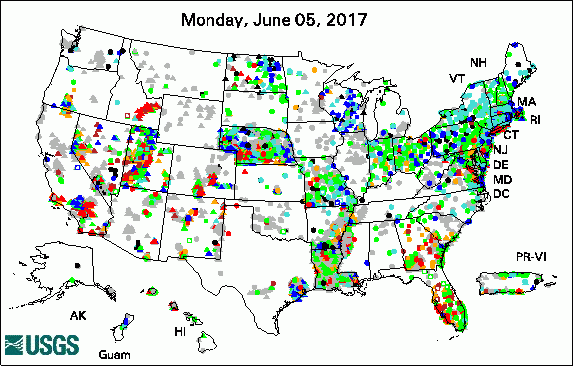USGS Groundwater Information
|
USGS Groundwater Information > July 5, 2017 Highlights USGS Monthly Groundwater News and Highlights: July 5, 2017Subscribe and get the latest USGS groundwater news and science sent to your inbox every month! Featured Product: High Plains Aquifer Groundwater Levels Continue to Decline![Map: High Plains aquifer water-level changes, predevelopment (about 1950) to 2015. [ Map: High Plains aquifer water-level changes, predevelopment (about 1950) to 2015. ]](images/feature/20170701_hp_wlcpd15go.png)
High Plains aquifer water-level changes, predevelopment (about 1950) to 2015. Source: Figure 1 from USGS SIR 2017-5040. The USGS has released a new report detailing changes of groundwater levels in the High Plains aquifer. The report presents water-level change data in the aquifer for two separate periods: from 1950 -- the time prior to significant groundwater irrigation development -- to 2015, and from 2013 to 2015. The change in storage for the 2013 to 2015 comparison period was a decline of 10.7 million acre-feet, which is about 30 percent of the change in recoverable water in storage calculated for the 2011 to 2013 comparison period. The smaller decline for the 2013 to 2015 comparison period is likely related to reduced groundwater pumping. Learn more:
USGS Groundwater-Related Press Releases 
The USGS Active Groundwater Level Network includes about 20,000 wells that have been measured by the USGS or USGS cooperators at least once within the past 13 months. The animation shows a daily snapshot of water-level statistics in the network for June 2017. Credit: USGS. The image is in the public domain. Human Activity Alters Streamflow Throughout Kansas (06/26/17) USGS: High Plains Aquifer Groundwater Levels Continue to Decline (06/16/17)
USGS Groundwater-Related PublicationsStreamflow alteration at selected sites in Kansas (06/26/17) Groundwater quality in the Bear Valley and Lake Arrowhead Watershed, California (06/22/17) Archaeal diversity and CO2 fixers in carbonate-/siliciclastic-rock groundwater ecosystems (06/30/17) Groundwater quality in the western San Joaquin Valley, California (06/22/17) Hydrogeologic framework and hydrologic conditions of the Piney Point aquifer in Virginia (06/07/17) Depletion mapping and constrained optimization to support managing groundwater extraction (06/07/17) Measuring surface-water loss in Honouliuli Stream near the 'Ewa Shaft, O'ahu, Hawai'i (06/22/17)
USGS Groundwater-Related Software Updates and New ReleasesUSGS Groundwater Flow and Transport Model Data ReleasesNote: The following links take you to data.gov Field PhotosDuring the cold Alaska winters, groundwater discharging in springs at the ground surface freezes, causing thick accumulations of ice called aufeis in areas with permafrost. Scientists from the USGS Office of Groundwater, Branch of Geophysics and the Crustal Geophysics and Geochemistry Science Center are using geophysics to study aufeis features, including potential thawed zones beneath. Geophysical tools provide us with noninvasive ways to see through ice and the earth, much like how medical imaging lets us see inside the human body. In these photos from April 2017, USGS Research Hydrologists Neil Terry and Martin Briggs collect ground-penetrating radar (GPR) data. Using hydrogeophysical tools such as GPR enables scientists to collect images of the structure and conditions of the ice below them. Learn more about this project and see more photos. Archive of Past Highlights: |